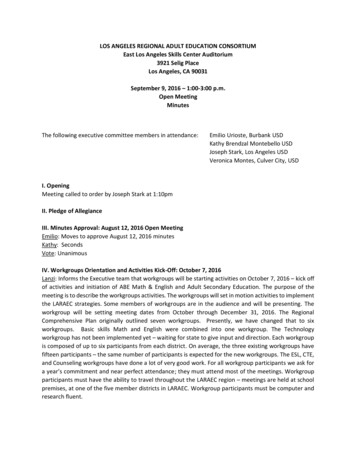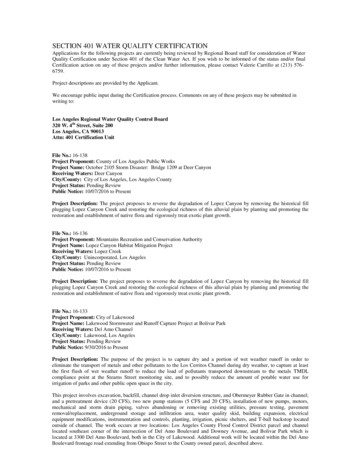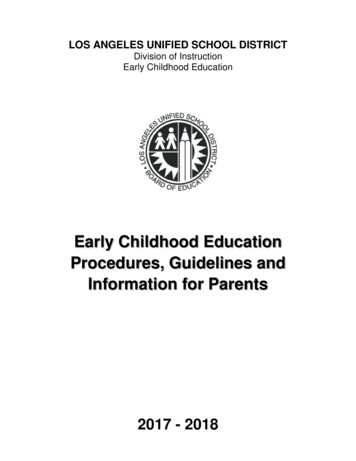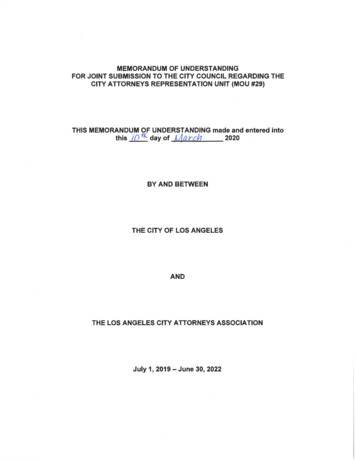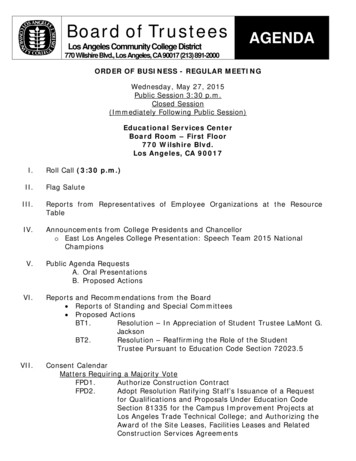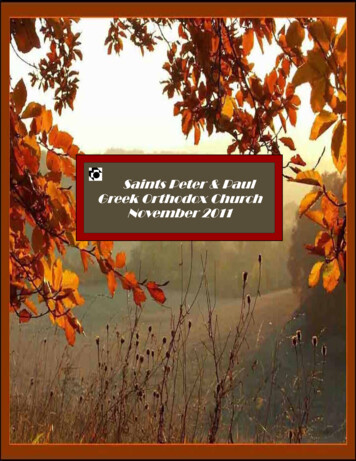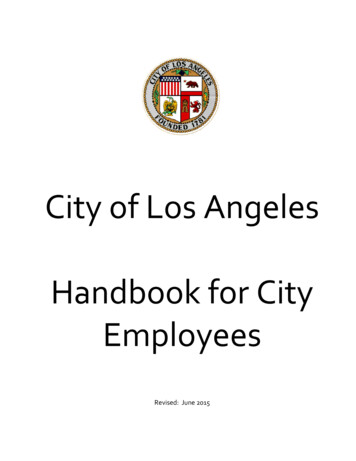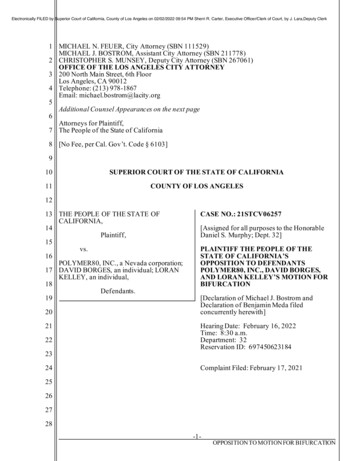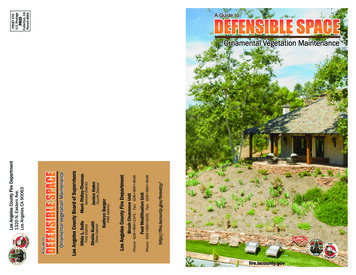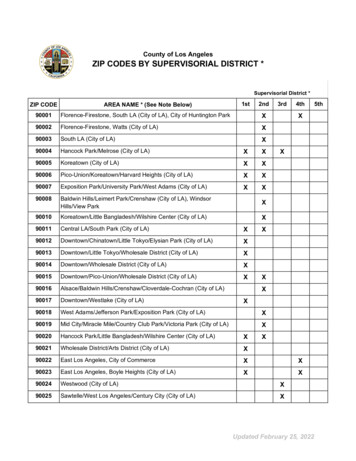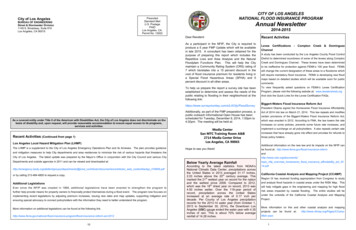
Transcription
CITY OF LOS ANGELESNATIONAL FLOOD INSURANCE PROGRAMPresortedStandard MailU.S. PostagePAIDLos Angeles, CA.Permit No. 12932City of Los AngelesBUREAU OF ENGINEERINGStreet & Stormwater Division1149 S. Broadway, Suite 810Los Angeles, CA 90015Annual Newsletter2014-2015Dear Resident:As a participant in the NFIP, the City is required toproduce a 5 year FMP Update which will be availablein late 2015. A consultant has been obtained for thepurpose of preparing this report which includes theRepetitive Loss and Area Analysis and the NaturalFloodplain Functions Plan. This will help the Citymaintain a Community Rating System (CRS) rating of7 which translates into a 15 percent discount in thecost of flood insurance premium for residents living ina Special Flood Hazardous Areas (SFHA) and 5percent discount in all other areas.To help us prepare the report a survey site has beenestablished to determine and assess the needs of thepublic relating to flooding in their neighborhood at thefollowing rveyAs a covered entity under Title II of the American with Disabilities Act, the City of Los Angeles does not discriminate on thebasis of disability and, upon request, will provide reasonable accommodation to ensure equal access to its programs,services and activities.Additionally, as part of the FMP preparation process, apublic outreach Informational Open House has beenscheduled for Tuesday, December 9, 2014, 1:00pm to4:30pm. The meeting will be held at:Media CenterSan MTC Training Room A&B2714 Media Center DriveLos Angeles, CA 90065Recent Activities (Continued from page 1)Los Angeles Local Hazard Mitigation Plan (LHMP)The LHMP is a supplement to the City of Los Angeles Emergency Operations Plan and its Annexes. The plan provides guidanceRecent ActivitiesLevee Certifications - Compton Creek & DominguezChannelA study has been conducted by the Los Angeles County Flood ControlDistrict to determined soundness of some of the levees along ComptonCreek and Dominguez Channel. These levees have been determinedto be ineffective for protection against FEMA’s 100 year flood. FEMAwill change the current designation of these areas to a floodzone whichwill require mandatory flood insurance. FEMA is developing new floodmaps based on detailed studies which will be available soon for publiccomments.To view frequently asked questions on FEMA’s Levee CertificationProgram, please visit the following website at: www.lawatersheds.orgAnd click the Quick Links for the Levee Certification FAQs.Biggert-Waters Flood Insurance Reform ActPresident Obama signed the Homeowner Flood Insurance AffordabilityAct of 2014 into law on March 21, 2014. This law repeals and modifiescertain provisions of the Biggert-Waters Flood Insurance Reform Act,which was enacted in 2012. According to FMA, the law lowers the rateincreases on some policies, prevents some future rate increases, andimplement a surcharge on all policyholders. It also repeals certain rateincreases that have already gone into effect and provides for refunds tothose policy holders.Additional information on the new law and its impacts on the NFIP canHope to see you there!be found at: http://www.fema.gov/flood-insurance-reformand mitigation measures to help City departments and area residences to minimize the risk of various hazards that threatens theandCity of Los Angeles. The latest update was prepared by the Mayor’s Office in conjunction with the City Council and various Cityhttp://www.naic.org/documents/Departments and outside agencies in 2011 and can be viewed and downloaded artments/@emd contributor/documents/contributor web content/lacityp 019906.pdfor by calling 213-484-4800 to request a copy.Additional LegislationsEver since the NFIP was created in 1968, additional legislations have been enacted to strengthen the program tofurther help provide means for property owners to financially protect themselves during a flood event. The program now focuses onimplementing recent legislations by adjusting premium increases, issuing new rates and map updates, supporting mitigation andensuring special advocacy to connect policyholders with the information they need to better understand the program.More information on additional legislations can be found at the following program/flood-insurance-reform-act-201210Below Yearly Average Rainfalltopic nfip overview homeowner flood insurance affordability act 20According to the latest statistics from NOAA’sNational Climatic Data Center, precipitations acrossthe United States in 2013 averaged 31.17 inches,2.03 inches above the 20th century average. Thismarked the 21st wettest year on record for the nationand the wettest since 2009. Compared to 2012,which was the 18th driest year on record, 2013 was4.50 inches wetter. Over the 119-year period ofrecord, precipitation across the United Statesincreased at an average rate of 0.17 inch perdecade. Per County of Los Angeles precipitationrecords for the 2013-14 water year (from October 1,2013 to September 30, 2014), the Downtown LosAngeles (USC) gauge ended the water year with 4.35inches of rain. This is about 70% below averagerainfall of 14.28 inches.14.pdfCalifornia Coastal Analysis and Mapping Project (CCAMP)Region IX has received funding appropriation from Congress to studyand analyze flood hazards in coastal areas under the RISK Map. Thiswill help mitigate gaps in the engineering and mapping for high floodrisk areas impacted by coastal flooding.The entire studies will beunder the umbrella of the California Coastal Analysis and MappingProject.More information on this and other coastal analysis and mappingprojects can be found at:Main.aspx1http://www.r9map.org/Pages/CCamp-
NATIONAL FLOOD INSURANCE PROGRAM (NFIP)CITY SERVICES AND PHONE LISTFor Information & ServicesNFIP FEMA phone numbersThe NFIP is a Federal program enabling property owners inparticipating communities to purchase protection againstproperty losses due to flooding. This insurance is designedto provide an insurance alternative to disaster assistance tomeet the escalating costs of repairing damage to buildingsand their contents.General InformationNeed a Flood Insurance Agent?Please call(800) 427-4661(800) 720-1093Why Flood Insurance is better than DisasterAssistance?Flood insurance covers direct losses caused by surfaceflooding, including a river flowing over its banks, a lake orocean storm (including tsunami and seiches), and localflooding.Flood Insurance You are in control. Flood insurance claims are paid even ifa disaster is not declared by the President.There is a 30 day waiting period before the policybecomes effective. Between 20 and 25 percent of all claims paid by the NFIPare outside of an SFHA.There are two types of coverage: Structural and Contents.Structural coverage is for the walls, floors, insulation, furnaceand other items permanently attached to the structure.Contents coverage, purchased separately, requires thecontents to be in an insurable structure. There is no payback requirement. Flood insurance policies are continuous, and are not nonrenewed or cancelled for repeat losses. Flood insurance reimburses you for all covered losses upto 250,000 for homeowners and 500,000 forbusinesses.Insurance Premium DiscountDue to the City of Los Angeles' active participation in theNFIP and CRS, new and renewed flood policies in SFHAcontinue to receive a 15% premium discount. Through theNFIP, flood insurance is available to all City residents whowish to purchase flood insurance regardless of their flood riskor flood history. Properties located outside the SFHA receivea 5% premium discount. The average flood insurance policy costs about 650 peryear. For a 100,000 flood insurance coverage, your premiumpayment is about 400 a year ( 33 a month).Disaster AssistanceInsurance agents should use the latest Insurance Manual inorder to apply the discount automatically. This manual isavailable on the Web at: Most forms of federal disaster assistance require apresidential nual Federal disaster assistance declarations are awarded inless than 50% of flooding incidents.Flood FactsEveryone lives in a flood zone. Floods and flash floodshappen in all 50 states. Most homeowners insurance doesnot cover flood damage. Just an few inch of water can causecost tens of thousands of dollars in damage to your property.A car can easily be carried away by just two feet of floodwater.If you live in an SFHA or high-risk area and have a Federallybacked mortgage, your mortgage lender requires you to haveflood insurance. In a high-risk area, your home is more thantwice as likely to be damaged by flood than by fire. Flashflood often brings 10 to 20 feet wall of water. If you live in amoderate-to-low risk area and are eligible for the PreferredRisk Policy, your flood insurance premium may be as low as 129 a year, including coverage for your property's contents.You are eligible to purchase flood insurance as long as yourcommunity participates in the National Flood InsuranceProgram. Anyone can be financially vulnerable to floods.From 2003 to 2012, flood insurance claims averaged nearly 4 billion per year. The most typical form of disaster assistance is a loan thatmust be repaid with interest. The duration of a Small Business Administration (SBA)disaster home loan is approximately 30 years. The average Individuals and Households Program awardis about 3,000. Repayment on a 50,000 SBA disaster home loan is 240a month or 2,880 annually at 4% interest. This comesout to more than 8 dollars per day.Over 5.5 million people currently hold flood insurance policiesin more than 21,800 communities across the U.S. From 1978,the NFIP has paid over 48.1 billion for flood insurance claimsand related costs (as of 7/08/13). Since the City of LosAngeles participates in the CRS, you can qualify for aninsurance premium discount of up to 45%. For more policyand claim statistics, visit the National Flood InsuranceProgram d facts.jspFree Flood InformationBefore you build in the floodplainThe City of Los Angeles provides free flood zoneinformation. Copies of the Federal EmergencyManagement Agency Flood Insurance Rate Maps areavailable for review in all Bureau of Engineering districtoffices. For flood zone information and availability ofelevation certificates, contact us by email atEng.nfip@lacity.org, or call (213) 485-4820 (call back timeis within 2 business days). This information is alsoavailable to you directly through the Internet at: http://navigatela.lacity.orgAll new development and construction in the floodplain isregulated and requires a special review before a buildingpermit is issued.Contact the NFIP Information Line at (213) 485-4820, or byemail at: Eng.nfip@lacity.org during the planning stages toinquire about the regulations applicable to your project.Suspected illegal floodplain development can be reported atthe same number.Hillside ProblemsInvestigation of Drainage DeficienciesReport problems with hillsides as well as temporary erosioncaused by construction projects, and alteration ormodifications to natural drainage that affect your property tothe Building and Safety Call Center at: (888) 524-2845.Request a drainage investigation when the water in thestreets overtops the curb by calling your local Bureau ofEngineering (BOE) District office:Harbor District(310) 732-4690West L. A.(310) 575-8617You can download the brochure “Be Prepared:Homeowner’s Guide for Flood, Debris, and Erosion Control”published by the City of Los Angeles, Department ofBuilding and Safety at:Valley District(818) 374-4643http://www.ladbs.org/LADBSWeb/LADBS Forms/Publications/floodmit.pdfCentral District(213) 485-1604or call to request a copy at: (888) 524-2845.Report Clogged Catch BasinsIf requested, a staff engineer from BOE will visit yourproperty to review your flood problem and explain ways tostop flooding or prevent flood damage. Call the NFIP infoline at (213) 485-4820. These services are free.The City of Los Angeles Bureau of Sanitation routinelycleans out the city's 35,000 catch basins at least once ayear, some with more frequency. However, if yourneighborhood catch basin becomes clogged with debris,please call the City Hot Line (800) 974-9794 between 8 a.m.and 4 p.m. Monday through Friday, or (213) 485-7575 after4 p.m. and on weekends.Illegal DumpingUsed motor oil, discarded food, trash and other debris arejust some of the items routinely dumped into storm drainsthroughout the city. Curbside catch basins are the entrypoints of the storm drain system, which eventuallydischarges out into the ocean. Additionally, catch basinsfilled with debris can create unhealthy conditions inresidential neighborhoods by becoming a breeding groundfor rats, roaches and disease.And remember, storm drains are for rainwater only!Sand BagsFree sand and sandbags are offered through the FireStations and the Bureau of Street Services yards during thestorm season. A complete list of maintenance yards andlocal fire stations offering sand bags is available on line atthe following web site (or call 311 to request a copy of thislist).An ordinance passed in 1999 (LAMC Sec 64.70) makes itillegal to dump or discharge trash, debris, chemicals,contaminated water, or any other liquid or solid materialinto the storm drain system. Violators are subject to stifffines and criminal m.htmFlood Protection LibraryResidents are encouraged to report illegal dumping bycalling the Stormwater Program at (800) 974-9794. Pleasenote: after 5:00PM and before 7:00AM Monday throughSaturday and all day Sunday the (800)-974-9794 will rollover to the City's 311 number. More information areavailable at: www.Lastormwater.orgAdditional information regarding flood protection, floodplainmanagement and the NFIP can be found through the FEMAweb site at: www://fema.govContinue on page 323119
DRAINAGE SYSTEM MAINTENANCEThe original storm drain system was developed in the 1930by the Army Corps of Engineers. As the City began to growrapidly in the 1920s and 1930s, rainwater that was onceabsorbed by miles of undeveloped land began to run offthe newly paved and developed areas, increasing amountof water flowing into Los Angeles rivers and local creeks.These waterways could not contain the increased amountof water and the region experienced massive flooding.Because of this, the Army Corp of Engineers lined the LosAngeles River and Ballona Creek with concrete and startedthe development of an underground urban drainagesystem. As Los Angeles continued to grow, a complexdrainage system developed.Mudslides from slope failures are also common problems. Iferosion on your property is a problem or if others have changethe normal drainage patterns, you can call (213) 485-4820 torequest an investigation, or information on how to protect yourhome. Sandbags are provided free during the rainy season(please refer to the City Services Phone List provided).Street Drainage ProblemFlooding may occur when street runoff enters private property.If the property is located on a street sump area (lowest point ofthe nearby streets), or if the building pads on these propertiesare lower than the street level, and/or the driveway is slopedtoward the house and garage, the street flow can pond.Drainage problems can be caused by undersized or broken Citystorm drains, or clogged City catch basins. If this problemapplies to you, you can call the Bureau of Engineering torequest a drainage investigation, and the Bureau of Sanitationat (800) 974-9794 to request that the catch basins be cleanedor obstructions removed from City drains.Today, the City’s storm drain system total 35,000 catchbasins, over 1,500 miles of underground pipes, and 100miles of open channels. Runoff from approximately 1,060square miles of developed land reach Santa Monica andSan Pedro Bays through approximately 60 storm drainoutfalls. Approximately 100 million gallons of water flowthrough Los Angeles' storm drain system on an averagedry day. When it rains, the amount of water flowing throughthe channels can increase to 10 billion gallons reachingspeeds of 35 mph and depths of 25 feet. Runoff fromstreets, parking lots, yards, etc. enters the storm drain,receives no treatment and flows directly to the ocean. Paintthinner and paint products, motor oil, pesticides, Styrofoamcups, paper, human and animal wastes, antifreeze, golfballs, dirty diapers and dead animals are found everyday inthe storm drain system. Every year, roughly 40 tons oftrash and debris are deposited onto our local beaches fromstormwater runoff. It’s important to our environment andsafety that we keep our waterways clean.On-Site Drainage ProblemWhen private drain inlets or v-ditches are inadequate orbecome plugged with yard debris, water ponds within theproperty and cannot drain to the street. Underground garageswith insufficient drainage are also commonly flooded.Other HazardsThese properties have site-specific problems that need specialand individual attention. For example:A stream is a watercourse that is naturally occurring swaleor depression, or engineered channel which carries freshor estuarine water either seasonally or year round. It is thedesire of the City of Los Angeles to protect streams andthe native riparian area vegetation along stream systemsand riparian areas. Los Angeles Municipal Code Sections64.07,64.08, and 64.09 prohibit anything that obstructs orinterferes with the flow of water through a water course orchannel in any manner without proper permits. Buildings damaged by coastal flooding exacerbated by astorm drain failure; Catastrophic rains far exceeding drain capacity; Buildings built too low into the bed of a naturalwatercourse; Groundwater seepage enters the lower level of thehouse, flooding the basement after heavy storms.Flood Prevention TipsIf you want to know more about our storm drainsystem, please log on to: Keep drainage areas (ditches, swales, small channels)free of debris.http://www.lastormwater.org Consult an engineer to design a permanent water/flooddebris control device, if needed.Typical Flood ProblemsHillside Drainage ProblemThis occurs on properties located at the bottoms of steephills. Floods happen when the drainage system is deficientor inadequately designed. Runoff is not diverted to thestreet and enters the home or garage. In some situations,neighbors change the normal drainage patterns, creatingflood risks to other properties. Ensure that drainage pipes within your property arecleared and work properly. Landscape slope areas with plants suitable for fireretardant and erosion control. Report clogged catch basins to request cleaning andfloodwaters overtopping the curb for engineeringinvestigations.8NFIP (Continued from page 2)way. Federal disaster assistance is usually a loan thatmust be paid back with interest. For a 50,000 loan at 4%interest, your monthly payment would be around 240 amonth ( 2,880 a year) for 30 years. Compare that to a 100,000 flood insurance premium, which is about 400 ayear ( 33 a month).Mandatory Purchase RequirementThe mandatory flood insurance purchase requirementapplies to all forms of federal or federally related financialassistance for buildings located in an SFHA. A homelocated within an SFHA has a 26 percent chance ofsuffering flood damage during the term of a 30-yearmortgage.If you live in a low-to-moderate-risk area and are eligiblefor the Preferred Risk Policy (PRP), your flood insurancepremium may be as low as 129 a year, includingcoverage for your property's contents.This requirement affects loans and grants for thepurchase, construction, repair, or improvement of anypublicly or privately owned building in the SFHA, includingmachinery, equipment, fixtures, and furnishings containedin such buildings.You are eligible to purchase flood insurance because theCity of Los Angeles participates in the NFIP. It takes 30days after purchase for a policy to take effect, so it'simportant to buy insurance before floodwaters start to rise.All claims and expenses of the NFIP program are fundedby insurance premiums, not tax dollars.The requirement also applies to secured mortgage loansfrom financial institutions, such as commercial lenders,savings and loan associations, saving banks, and creditunions that are regulated, supervised or insured byFederal agencies such as the Federal Deposit InsuranceCorporation and the Office of Thrift Supervision. It alsoapplies to all mortgage loans purchased by Fannie Maeor Freddie Mac in the secondary mortgage market.Financial AssistanceFinancial assistance includes loans and grants fromagencies such as the Department of Veterans Affairs,Farmers Home Administration, Federal HousingAdministration, Small Business Administration, andFEMA.How It WorksFEMA Grant AssistanceBefore a person can receive a loan or other financialassistance from one of the affected agencies or lenders,there must be a check to see if the building is in an SFHA.SFHAs are land areas that are at high risk for flooding.These areas are indicated on the Digital Flood InsuranceRate Map (DFIRM). It is shown as one or more zones thatbegin with the letter “A” or “V”.Grant assistance is provided to those who have suffereddamage and loss from disasters occurring in that state.When there is a presidential declaration, FEMA beginsaccepting assistance applications for a period of time thatvaries depending on the scope and magnitude of thedisaster, as well as affected areas and amendments to thegovernor’s declaration request. Those applicants may beeligible for FEMA grant money. This disaster assistancedoes not have to be repaid and is to be used for vitalexpenses that cannot be managed via other means.Many lenders and insurance agents also have copies ofthe DFIRM for the City of Los Angeles. It is the lender’sresponsibility to check the DFIRM to determine if thebuilding is in an SFHA. If the building is in an SFHA, yourlender is required by law to require you to purchase aflood insurance policy on the building. Federal regulationsrequire purchase of structural insurance coverage equal tothe amount of the loan or the maximum amount availablefrom the NFIP, whichever is less. The maximum amountavailable for a single-family house is 250,000 forstructure and 100,000 for its contents.Increased Cost of Compliance (ICC)CoverageIf your property is damaged by flood, you may be requiredby law to bring your home up to community and/or statefloodplain management standards. If you have NFIPinsurance, and your home has been declared substantiallydamaged by your community, ICC coverage is provided tocover up to 30,000 of the cost to elevate, floodproof,demolish, or relocate your property. ICC coverage is inaddition to the coverage you receive to repair flooddamage; however, the total payout on a policy may notexceed 250,000 for residential buildings and 500,000for non-residential buildings.The mandatory purchase requirement does not affectloans or financial assistance for items that are not coveredby a flood insurance policy, such as vehicles, businessexpenses, landscaping, and vacant lots. It does not affectloans for buildings that are not in the SFHA, even though aportion of the lot may be flood prone. While not mandatedby law, a lender may require a flood insurance policy as acondition of a loan for a property in any zone on a DFIRM.ICC coverage does not apply to substantial improvementsunless a structure is substantially damaged due toflooding. More information on ICC can be found at:The most important thing you can do to protect yourselffrom financial loss is to have flood insurance. Floods canalso pose life-threatening risks to you and your family, sobe smart. Be prepared for anything nature sends yourhttp://www.fema.gov/library/viewRecord.do?id 14773
FLOOD ZONEFlood Zone MapThe flood zone map of the City of Los Angeles is included asan insert of this newsletter. If you want to verify whether or notyour property is located within a flood zone, you can log on at:http://navigatela.lacity.org or email us at Eng.nfip@lacity.orgor call (213) 485-4820.The Bureau of Engineering keeps copies of the DFIRM for theCity of Los Angeles. If you have recently purchased or refinanced your home, your lender may require you to obtain aflood insurance policy. Whether you own or rent the propertyyou live in, you need to know the flood risks associated withthe flood designation in order to take precautions that protectyour interests. The City of Los Angeles prepares annualmailing to provide you with information that may help youunderstand and reduce the flood risk surrounding your home.If you have questions regarding this publication, you can emailthe City of Los Angeles at Eng.nfip@lacity.org or call (213)485-4820. If you received this newsletter in error, pleasedisregard.What Can Homeowners Do if They Believe TheirHomes are Erroneously Included in the FloodZone ?If a homeowner can show that the home is located above theBase Flood Elevation (BFE) he/she can apply for a mapamendment by completing an application for a Letter of MapAmendment (LOMA) and submitting this request to FEMA. ALOMA application (known as MT-EZ) can be obtained on lineat: http://www.fema.gov/formsNo basements for residential structures located in the floodzones will be permitted in new buildings. Substantialimprovements and substantial damage residential projects(including multiple residential units) will be required to sealany existing basements.Mandeville Canyon is considered a Flood Risk Area anddevelopers are likely to be required to obtain a watercoursepermit per Special Order SO003-1005. A copy of the SpecialOrder can be obtained by emailing a request toEng.nfip@lacity.org.If your property is in the flood zone, please contact the City’sNFIP information line at (213) 485-4820 or email us at:Eng.nfip@lacity.org before designing your project.What is Substantial Improvements?Any reconstruction, rehabilitation, addition, or otherimprovement of a structure, the cost of which equals orexceeds 50 percent of the market value of the structurebefore the "start of construction" of the improvement. Thisterm includes structures which have incurred "substantialdamage," regardless of the actual repair work performed.The term does not, however, include either: Any project for improvement of a structure to correctexisting violations of state or local health, sanitary, orsafety code specifications which have been identified bythe local code enforcement official and which are theminimum necessary to assure safe living conditions orFEMA’s review is free to individual property owners who applyfor single lot LOMA review. However, a RegisteredProfessional Engineer or Licensed Land Surveyor will need tobe hired by the homeowner to certify the elevation informationin the application. More information is available by accessingFEMA’s web site at: -revision-based-fill-processIf you would like assistance in completing a LOMA applicationfrom a Map Specialist, you may call the FEMA MapAssistance Center toll-free at (877)-FEMA-MAP or (877)-3362627. Please note that the City does not approve or deny anymap amendment requests since the FIRM are published by afederal agency.Building or Remodeling in the Flood ZoneAll developments in the floodplain, not just construction ofbuildings, need local permits.The Lowest Finished Floor (LFF) of all new buildings andexisting building undergoing substantial improvement(including remodeling) located in SFHA must be one foothigher than the expected Base Flood Elevation (BFE) per CityOrdinance No. 172081. Any alterations of a "historic structure," provided that thealteration will not preclude the structure's continueddesignation as a "historic structure."Floodplain management requirements apply to newconstruction and substantial improvements.What is a Floodplain and Special Flood HazardAreas (SFHA)?Floodplain is defined as any land area susceptible to beinginundated by flood waters from any source.SFHAs are areas subject to inundation by a 100-year flood, aflood that has a 1-percent or greater chance of being equaledor exceeded during any given year. They are shown on theDFIRM as zones labeled with the letters A, AO, AH, A1-A30,AE, A99, AR, AR/AE, AR/AO, AR/A1-A30, AR/A, V, VE, andV1-V30. In an SFHA, there is at least a 1 in 4 chance offlooding during a 30-year mortgage. All home and businessowners in these areas with mortgages from Federallyregulated or insured lenders are required to buy floodinsurance.For a more thorough explanation of a Floodplain and SFHAplease check out:Certain flood hazard areas are considered floodways orpassages to the 100-year flow, therefore, no new developmentwill be allowed. Other areas that experience high velocity flowand heavy debris loads may require special n-management/flood-zones4PERSONAL SAFETY DURING A FLOODThe most visible features of the City of Los Angeles are the270 miles of open flood control channels, which include theLos Angeles River, Dominguez Channel, and Ballona Creek.They serve to collect rainwater from most of the City’s stormdrains and smaller open channels, and move the water outto either the Santa Monica Bay or San Pedro Bay. When itrains, it fills up with fast flowing water that can kill anyonewho gets caught up or swept away in it. It is illegal to enterthe flood control channels at anytime.Tsunami - What to DoTsunamis (pronounced soo-ná-mees), also known asseismic sea waves (mistakenly called “tidal waves”), are aseries of enormous waves created by an underwaterdisturbance such as an earthquake, landslide, volcaniceruption, or meteorite. A tsunami can move hundreds ofmiles per hour in the open ocean and smash into land w
Los Angeles, CA 90065 Hope to see you there! NATIONAL FLOOD INSURANCE PROGRAM Annual Newsletter 2014-2015 City of Los Angeles BUREAU OF ENGINEERING Street & Stormwater Division 1149 S. Broadway, Suite 810 Los Angeles, CA 90015 As a covered entity under Title II of the American with Disabilities Act, the City of Los Angeles does not discriminate .
